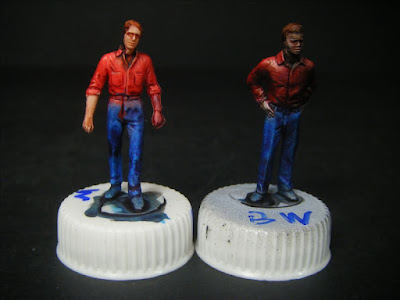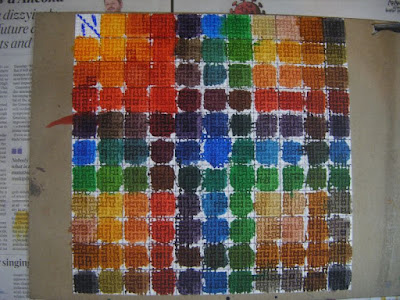Before I crack on with a return to some actual figure painting, I decided to do some proper initial tests of the Army Painter Speedpaints I bought a few weeks ago.
On Model Railway People
Yesterday afternoon I quickly (and a little messily to be totally honest) used the Speedpaints on the four model railway figures I primed a short while back. One figure had been primed white, one pale grey and two were primed black with white zenithal highlights. Not all the colours in the starter set were tested.
Top Tip: Avoid the temptation to use the biggest brush you think you can get away with. You can't! These were done with an Army Painter "Regiment" brush and it was difficult to control where the paint went (although that might have been due to too much paint in the brush).
 |
| White primer, grey primer |
 |
| Black/white zenithal primer |
 |
| Grey primer, black/white zenithal |
 |
| White primer, black/white zenithal |
1. Does mixing the Speedpaints with matt medium or matt varnish stop the reactivation? Does it stop them performing correctly?
2. Try different primer surfaces (spray primer, brush on primer, airbrush primer, varnished airbrush primer).
3. Try different primer colours (including metallic).
Mixes
With just ten paints in the starter set, I thought it would be a good idea to see how well the different colours mix (mixing turned out to be no problem) and what colours could be produced by doing so.
I planned to do 1:1 and 1:3 mixes, and the best way I could think of was to test each mix on the same texture. The easiest way to do that would be to use a regular-patterned wallpaper. So, off to B&Q I went to get a free sample. I then cut out some 22cm x 22cm squares and ruled an 11 x 11 grid on two of the pieces, fixed them onto art board with spray mount adhesive then gave them a couple of good coats of varnish to seal the surface.
After leaving them to dry for a couple of hours, I marked one for the 1:1 mixes and the other for the 1:3 mixes. Then I cracked on with mixing and applying the mixes.
Top Tip: Clean your palette within a few minutes of mixing Speedpaints on it to avoid permanent stains - running under the hot tap for a few seconds should do the trick.
Guide to grid - L to R and Top to Bottom: Zealot Yellow, Fire Giant Orange, Bloody Red, Hive Dweller Purple, Highlord Blue, Orc Skin, Pallid Bone, Crusader Skin, Hardened Leather, Gravelord Grey.
1:1 Mixes
 |
| 3 parts - colour across top; 1 part - colour down left side |
As you can see, mixing in different proportions produces a good range of greens, browns and blues.
Pallid Bone and Crusader Skin are weak; Zealot Yellow is a bit less weak; Fire Giant Orange, Hive Dweller Purple, Hardened Leather and Gravelord Grey are quite strong; Bloody Red, Highlord Blue and Orc Skin are the strongest of these.
Now that the full range is available as singles, I might get a few of the other colours. The "white" and the black are definitely on my list.
Other Tests To Do
1. Varnish the painted figures and then test reactivation.
2. I'm sure another will occur to me at some point.




You've confirmed some points that I had read on other blogs as well, and the reactivation appears to be a big problem, even after a few days, thanks for sharing your findings
ReplyDeleteYou're welcome! If used as intended (single coat and done), I don't think that the reactivation is an issue, provided you are neat and stay within the lines when painting. It only becomes an issue if you don't do that and need to touch up areas or if you intend to paint additional highllghts.
DeleteVery interesting, it looks like they are better than the Citadel Contrast paints I tried. Like them a White/ Grey base colour looks best to me?
ReplyDeleteI look forward to seeing part 2!
I haven't tried the Contrast paints, so can't really compare them. They definitely work best over a lighter primer - I will be trying a few different pale primer colours, with and without a zenithal.
DeleteVery thorough. Thanks for going to the effort of publishing this for others' benefit. That is the first I have heard about them reactivating and bleeding through, so I will watch your further experiments with interest.
ReplyDeleteIt was certainly a good initial test to highlight other tests that need to be done. Almost all of the YouTube videos I saw have mentioned the reactivation, so I wanted to test it for myself.
DeleteI'm contemplating thinking of getting a load of these. I too shall watch with interest.
ReplyDeleteI'd suggest waiting a while until you see how my tests turn out.
DeleteExcellent. A very interesting post and looking forward to the next - especially regarding the varnishing aspect.
ReplyDeleteHopefully I'll have the results soon!
DeleteGreat post. Thanks for doing it and going into such detail.
ReplyDelete